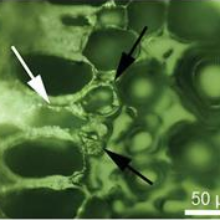It is assumed that special structures in aerial roots of leafless orchids, aeration units, are involved in gas exchange regulation. In this study, the structure of aeration units in three leafless taxa (Microcoelia exilis, M. aphylla, Dendrophylax funalis) and a leaf-bearing species (Campylocentrum micranthum) are investigated to obtain more evidence of a possible mechanism for gas exchange control in aerial orchid roots. Extensive analyses of the anatomy of the velamen radicum, exodermis and cortex were performed using light and electron microscopy and µCT. In all considered leafless taxa, the aeration unit consists of pneumathodes (non-wettable regions in the velamen radicum), an exodermal aeration cell (EAC) with a thin cell wall (often equipped with a special internal layer showing a fluffy structure) and specialized cortical cells (SCC). The SCC provide gaps for gas exchange, show differentially thickened cell walls and are arranged in a staggered manner. Based on the 3D structure of the aeration unit, we suggest the possibility of dehydration-triggered gap closure (driven by root shrinkage), in the process of which first the SCC are pushed against each other and second the EAC are squeezed shut by the exodermis.


